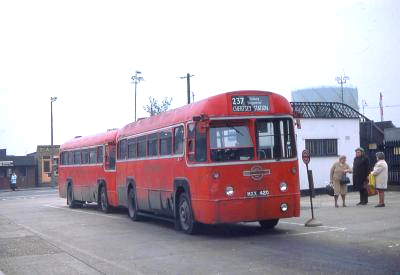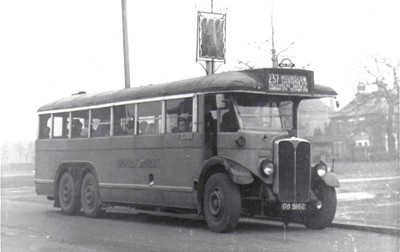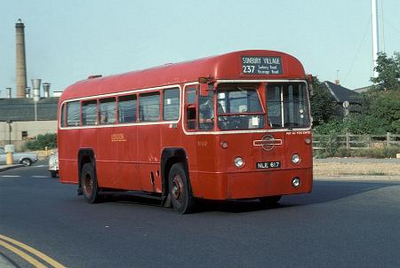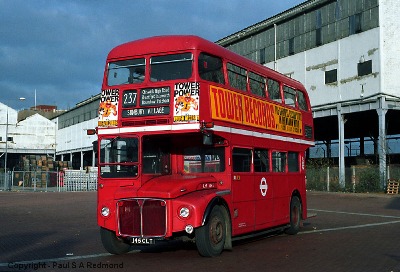|
|
 Red RF routes Red RF routes
Route 237
Page last updated 13 February
2017
This was London's longest-running RF route, pottering quietly
out in the western suburbs for almost a quarter of a century.
The rural part of the route was handed over to London Country
shortly after RF operation came to an end.
Three weeks before the RFs
leave the 237, RFs 443 and 452 stand at Chertsey
Station.
Photo © John Parkin
Dates of RF operation
3 Dec 52 to 16 Apr 77
(total 24 years 4 months, of which exactly half was
crew-operated and half one-man)
Destinations
HOUNSLOW Bus Station and CHERTSEY
STATION
 Reason for single-deck operation Reason for single-deck operation
A weight restriction on Chertsey Bridge meant that 1930s
double-deckers (with 56 passengers) were too heavy (56 passengers
weigh about 4 tons). Double-deck route 90 had covered the
section between Sunbury and Chertsey from 1923 to 1932,
first with Bs then Ks. In a parallel with the 1T1s on
Walton Bridge, the Ks were kept in
service because of the restriction. When they could be kept
running no longer, the 90 was replaced between Sunbury and Chertsey
by new route 137. It is not known what the weight restriction
was then - today it is 17 tonnes. Ken Glazier also mentions
that the Ks' high chassis frame meant that they were at the
time the 'only type of double-decker which could then cross
the heavily humped Chertsey Bridge' (the listed bridge is unchanged
today, although perhaps the road profile is different).
LT1057 running AV1 outside the Red Lion at
Feltham Green in January 1949. The Scooters were already 11
years old when they were introduced to the route in 1942; the
load in this shot certainly justifies the conversion to bigger
buses.
Photo © Alan Cross, Peter Gomm collection
Route history
The route was introduced by the General as the 137 in June
1932, replacing the 120 between Hounslow Heath and Feltham and the
90 between Sunbury and Chertsey. The route was one-man
operated daily by Dennis Darts (the early 18-seat version) and was
obviously popular at weekends; the Sunday allocation doubled over
the two years after introduction.
Becoming 237 in the route renumbering in 1934, the route was
then host for two years to the prototype C-class Leyland Cub, the
20-seat Chiswick-built class. At the beginning of the war, all the
remaining Darts were withdrawn and the route converted fully to Cub
operation, initially with the rear-engined CRs, then from 1941 with
Cs when the CRs were put into store, in both cases still OMO. But
the focus in wartime was to maximise capacity and bigger buses in
the form of the LTL Scooters (with perimeter seating to maximise
standing room) were introduced in November 1942.
 RF617, a former green bus repainted red whilst
at Muswell Hill, bowls round the Sunbury roundabout in 1976.
It appears to have had half its fleetname reapplied. Photo © Eamonn
Kentell
LTLs ran the 237 for 10 years, with a little help from Ts
(officially on Sundays between 1946 and 1950 and on Saturdays in
1949); these included ex-Tilling 3T3s, ex-Green Line 11T11s
and petrol-engined 1/7T7/1s, and later 10T10s. The
Scooters were over 20 years old when the route was converted to RFs
in 1952, one of the first batch of routes using brand-new
buses. The first two were licensed on 3 Dec 52 and conversion
completed on 9th, the spare bus RF367 being licensed on
10th. The two trainer RFs (ex-MH) were licensed in February
1953, allowing a summer increase in the Sunday allocation. A
few 14T12s also came and went between May 1953 and July 1954,
and a green 15T13 was allocated briefly in 1957.

Apart from the rebuilding of Hounslow Garage and the opening
of the bus station in 1954, the route ran unchanged for the nearly
25 years of RF operation. Half way through RF operation, on
27 Jan 65, the 237 became OMO again.
Hounslow's RFs were usually in a bit of state
by the end of nearly 25 years' operation of the class. RF354,
now back on the scene after a long break, heads out from the bus
station on a Shepperton short working.
Photo © Paul Redmond
In April 1977, Hounslow lost its RFs from both the 237 and
202, leaving only Kingston operating
the class. They were replaced on the 237 by BL-class
Bristols for 9 months, before Routemasters took over a transformed
route in January 1978.
Gone was the semi-rural section from Sunbury Village to
Chertsey, which became London Country route 459. The 237
instead headed east from Hounslow over the 117 roads to Shepherds
Bush, overnight becoming an important trunk route. Turnham
Green, later Stamford Brook (V) provided extra RMs on
Saturdays. Crew Metrobuses made an appearance in 1986 and the
following year the route became OPO for the third time.
 1996 saw the Hounslow Heath to Sunbury Village section
transferred to new route 235, which converted to single-deckers two
years later, with the main 237 continuing
to this day, now operated by Metroline from Brentford garage.
Hounslow's
RM1145 lays over at the old Shepherds Bush stand before
heading all the way to Sunbury Village. It is the mid-80s,
and the last assignment for the RM before it was sold.
Photo © Paul Redmond
RF route in detail, with timing points
HOUNSLOW Bus Station (Garage until 1954),
Hounslow High Street, Staines Road, Hounslow Heath Hussar, Hounslow
Road, Feltham Station, Feltham
High Street, Sunbury Road, Groveley Road, Vicarage Road, Bridge
Street, Sunbury Clock
Tower, Green Street, Sunbury Village Flower Pot,
Halliford Road, Gaston Bridge Road, Green Lane Gaston Bridge Road,
Green Lane, Shepperton Station
Approach, High Street, Church Road Shepperton, Chertsey
Road, Chertsey Bridge Road, Chertsey Bridge, Chertsey Cricketers, Bridge Road,
London Street, Guildford Road, CHERTSEY STATION
1955 bus map © London
Transport
Frequency
| Year |
Mon-Fri |
Sat |
Sun |
| 1936 |
30 mins |
20-30 mins |
15-30 mins |
| 1941 |
30 mins |
20-30 mins |
15-30 mins |
| 1946 |
20 mins |
20 mins |
20-30 mins |
| 1951 |
15-20 mins |
15-20 mins |
20 mins |
| 1959 |
15-20 mins |
15-20 mins |
20-30 mins |
| 1964 |
15-20 mins* |
15 mins |
30 mins |
| 1969 |
11-30 mins |
15-18 mins |
30 mins |
| 1971 |
13-30 mins |
15-18 mins |
30-60 mins |
| 1976 |
15-30 mins† |
25 mins† |
30-60 mins |
* Every 11-20 mins between Sunbury and Feltham
† Every 15 mins (Mon-Fri),12-13 mins (Sat) between
Sunbury and Hounslow.
The route took about 50 minutes from Hounslow
to Chertsey. The November 1959 timetable is
here and the July 1967
timetable here.
Faretable
The 1968 faretable is here.
RF allocation
New RFs delivered Dec 52: 357, 361-367, 376 (total 8 + 1
spare)
PVR 1952 (Dec): Mon-Fri 8, Sat 8, Sun 6
PVR 1953 (May): Mon-Fri 8, Sat 8, Sun 10
PVR 1953 (Jul): Mon-Fri 9, Sat 8, Sun 10
PVR 1953 (Oct): Mon-Fri 9, Sat 8, Sun 6
PVR 1954 (May): Mon-Fri 9, Sat 8, Sun 10
PVR 1954 (Oct): Mon-Fri 9, Sat 8, Sun 6
PVR 1955 (May): Mon-Fri 9, Sat 8, Sun 8
PVR 1955 (Oct): Mon-Fri 9, Sat 8, Sun 6
PVR 1956 (May): Mon-Fri 9, Sat 8, Sun 8
PVR 1956 (Oct): Mon-Fri 9, Sat 8, Sun 7
PVR 1957 (May): Mon-Fri 9, Sat 8, Sun 8
PVR 1957 (Oct): Mon-Fri 9, Sat 8, Sun 7
PVR 1958 (Apr): Mon-Fri 9, Sat 8, Sun 8
PVR 1958 (Nov): Mon-Fri 9, Sat 8, Sun 7
PVR 1959 (May): Mon-Fri 9, Sat 8, Sun 8
PVR 1959 (Oct): Mon-Fri 9, Sat 8, Sun 7
PVR 1960 (Mar): Mon-Fri 9, Sat 8, Sun 6
PVR 1960 (May): Mon-Fri 9, Sat 8, Sun 8
PVR 1960 (Oct): Mon-Fri 9, Sat 8, Sun 6
PVR 1961 (Oct): Mon-Fri 9, Sat 8, Sun 4
PVR 1962 (May): Mon-Fri 9, Sat 8, Sun 6
PVR 1962 (Oct): Mon-Fri 9, Sat 8, Sun 4
PVR 1963 (May): Mon-Fri 9, Sat 8, Sun 6
PVR 1963 (Oct): Mon-Fri 9, Sat 8, Sun 4
PVR 1965 (Jan, OMO): Mon-Fri 10, Sat 9, Sun 6
PVR 1966 (Feb): Mon-Fri 9, Sat 8, Sun 6
PVR 1967 (Jun): Mon-Fri 10, Sat 8, Sun 6
PVR 1969 (Feb): Mon-Fri 10, Sat 8, Sun 5
Then unchanged to 1977.
Re-creation
See details of Hounslow road run, 11
February 2018.
|
|